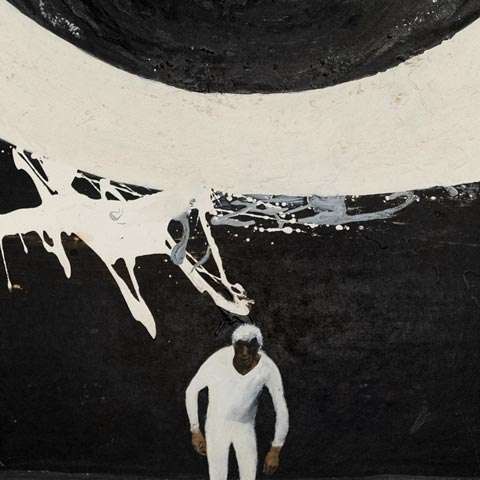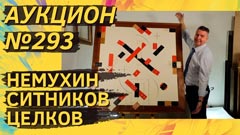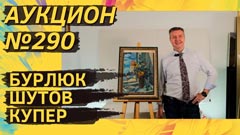
1960s UNOFFICIAL ART
BELENOK Petr Ivanovich (1938–1991) Unknown. 1991. Hardboard, mixed media. 170 × 100
“Unknown” is a painting from 1991, the last year of Belenok's life. And it has everything. The museum size in human growth. Deep elaboration: texture, relief, rare color combinations. Why is this important? Works of the inventor of “panic realism” can be very different in their technical complexity. Some “quick” graphics works are done very succinctly, literally in a single pass. Technical stinginess is also characteristic of many paintings by Petr Belenok. But that is not the case today. In “Unknown” Belenok gave his all. The work is multi-faceted, complex. And, what especially pleases a collector — Belenok painted his most important subject: a black “Unknown” (which simultaneously resembles a funnel and the Nemesis) hangs over a lonely man. A classic allegory of the pressure of a hostile world, the power of circumstances, evil fate, but at the same time it is also a hymn to human rebelliousness.
Recall. Petr Belenok is one of the main innovators of Soviet post-war unofficial art. And one of the most underestimated. The artist died in the year of the collapse of the USSR, at the beginning of the era of ethnic conflicts, a parade of sovereignties and economic hardships. At that time, the country was very uninterested in art. And not least because of this, the favorite of Costakis did not receive the appreciation and fame that he certainly deserved. The situation began to improve only ten years after the death of the artist. And in recent years we have witnessed unprecedented interest in his work. Prices for Belenok's paintings tripled between 2020 and early 2022.
MIKHNOV-VOITENKO Evgeny Grigorievich (1932–1988) White Square No. 1. 1981. Tempera on paper. 64 × 61.5
In front of us is one of the two works of the cycle “White Square” by the Leningrad nonconformist Evgeny Mikhnov-Voitenko. There is a paired piece to this tempera, “White Square No. 2”, but they are sold in turn. The title does not deceive — it is about the dispute with Malevich. About the global opposition. The white square against the black one. Mikhnov-Voitenko was passionate about the search for the ideal form and color all his life. The black square symbolized the “end of art”: without colour and unnatural, not existing in nature, form. And the white square is its antipode. Note that in Mikhnov-Voitenko this is not even a square, strictly speaking. It has different proportions. And the white color is not white either. Not ideal. Nor is the black colour of the black square ideal. Mikhnov-Voitenko's tempera pattern forms more of a white noise. But here, as in Malevich's square, what is important is not the ideal visuality, but the symbolism — the sign itself, the message itself.
Please note that the work is signed: in the lower right corner there is a monogram and the date: MV 81.
Mikhnov-Voitenko is considered to be an innovator of post-war abstraction. In a number of artistic approaches he surpassed the recognized masters. However, the “Iron Curtain” did not allow to fix this priority. In the USSR Mikhnov worked into the desk. To make money, he decorated restaurants and made signs at the art factory. But his independent work was seen only by a limited circle of friends. The artist died early, at the age of 56. It happened at the beginning of Perestroika, a perfect time to be forgotten for years. However, interest in his work is steadily growing. And the circle of collectors is expanding.
ZVEREV Anatoly Timofeevich (1931–1986) Pine. Sokolniki. 1958. Paper, charcoal, watercolor. 39.5 × 31
Inspirational watercolor of the most valuable period in the work of Zverev. Quick, virtuosic drawing. Sokolniki is the cradle and refuge of Zverev. Not far from the park, he studied in the art studio. In the park, his work was noticed by the actor Rumnev, who became his first patron. In Sokolniki, Zverev played checkers, kicked the ball, and drank until the end of his days. This was his second home. He came there in sorrow and in joy. Sokolniki remained his place of power — a “safe haven”, where the artist was gaining strength and drew inspiration.
1970s UNOFFICIAL ART
LUBENNIKOV Ivan Leonidovich (1951–2021) Woman with a pumpkin. 1998. Oil on canvas. 61 × 61
When you are in the renovated lobby of the Mayakovskaya metro station, look up. The mosaics on the ceiling with the poet's quotes are just the work of Ivan Lubennikov, a Soviet artist, muralist and painter. The facades of the Taganka Theatre and the Mayakovsky Museum are also his. He has a very recognizable stylistic imagery. Especially in the depiction of ladies. There are Botero, Samokhvalov and Kustodiev all at once. However, our “Woman with a pumpkin” is not a nude. Rather, a scene of touching surprise. The artist died in 2021. His paintings are in the Tretyakov Gallery and the leading museums of the country. A fan of his creativity was, in particular, the well-known collector Peter Ludwig.
KAZARIN Viktor Semyonovich (1948–2021) Dionysius. 1989. Oil on canvas. 90 × 60
Victor Kazarin is a neo-expressionist, a member of the group “21” that exhibited at the Gorkom of Graphic Arts on Malaya Gruzinskaya Street. The portrait depicted in the painting is an imaginary image of the icon painter Dionysius, a legendary follower of Andrey Rublev. Dionysius was one of Victor Kazarin's favorite artists. Every summer Victor Semyonovich travelled to Ferapontovo, where he spent a long time looking at the frescoes of the Nativity Cathedral in the Ferapontov Monastery.
CONTEMPORARY ART
SAVKO Alexander Andreevich (1957) Hylas and the Nymphs — 2. 2021. Acrylic on canvas. 100 × 80
Hylas or Gilas is one of the Argonauts, the companions of Hercules. He did not fall in battle, but disappeared without a trace on the island of Keos in the Aegean Sea. According to the legend, while Argo was anchored, young Hylas went in search of fresh water. There, by the water, he saw the nymphs, daughters of the rivers and mountains, who lured the young man to themselves and drew him into the abyss. “Hylas and the Nymphs” is one of the widespread erotic subjects in European painting. Alexander Savko reinterprets one of its artistic embodiments in his new palimpsest work.
- Log in to post comments










